 |
|

|
 |
TABLE of CONTENTS
|
3D sonar scans reveal whatís hidden underwater |
By Research Services & Library staff
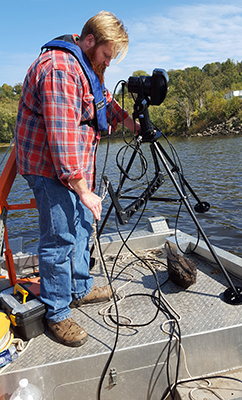
An engineer prepares to lower the tripod-mounted sonar unit into the St. Croix River in Stillwater. Photo courtesy of Collins Engineers |
MnDOT bridge inspectors often have to find out what lies beneath the surface of Minnesota’s rivers. Thanks to new sonar inspection technology, the Bridge Office now has a way to see previously hidden riverbed floors and underwater bridge structures in far better detail than ever before.
Typically, bridge engineers turn to professional divers to provide information about what’s underwater. But diving inspections don’t always deliver precise information about bridge damage, debris and riverbed topography.
Of the 11,183 Minnesota bridges that span waterways, about 585 require underwater inspection.
In recent years, bridge inspectors turned to underwater inspection technologies to identify areas of interest and direct divers who can inspect hands on. In turbid, sediment-heavy conditions with low visibility such as the Mississippi River, non-optical technologies – laser, radar and sonar – offer safe and useful options. Sonar gathers underwater acoustic data into point clouds for imaging two-and three-dimensional models of conditions.
In winter 2014, a vendor demonstrated the use of sonar at the Third Avenue bridge over the Mississippi River in Minneapolis, where a void was previously discovered during a diving inspection. Acoustic investigation of the frozen-over site delivered a three-dimensional image of a scoured cavity of eroded concrete under a pier in conditions unsuitable to diving inspection. Later that year, the Bridge Office purchased its own three-beam sonar unit with funds secured from MnDOT’s research implementation program. MnDOT is the nation’s first state transportation department to use the technology, according to Petra DeWall, waterway engineer.
The new 3D scanning technology provides much better information than divers can. Nicki Bartelt, hydraulic design engineer, said divers can see up to 2 feet in front of them in good rivers, so most of the work is done by feel.
With the new technology, Bartelt and her colleagues receive a 3D image to base decisions on. Diver reports included only narratives and rough sketches.
“It’s like night and day,” said Nicki Bartelt, hydraulic design engineer. “It’s a picture, but it’s more than that. It’s a point cloud. It’s totally scalable. It is real-world elevations and dimensions. It’s like the difference between Google Earth and a paper map.”
Although the information is far better from these scans, federal bridge inspection standards still require hands-on inspection of bridges, including substructures above and below the water’s surface. For now, the scans will be used to augment diver inspections and other purposes.
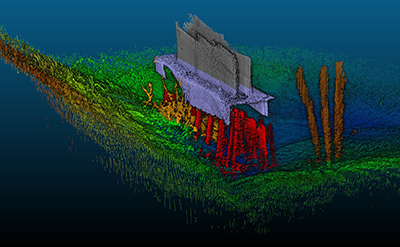
This 3D, colored sonar image shows underwater bridge conditions that include a tree caught among exposed piles beneath a bridge pier in the Rock River near Luverne. |
“We’re looking to augment with scans to make it safer for the divers,” DeWall said.
The research implementation team identified a host of lessons and best practices after purchasing and testing the new equipment.
“This does have a pretty steep learning curve,” Bartelt said. “It’s not something you can just buy and use. You have to learn how to use it.”
Getting different pieces of the equipment set up and able to communicate with each other was the first difficult step. Field testing also identified the need for a dedicated generator to provide a consistent portable power source because of difficulty with batteries.
Other lessons learned appear in the project’s research report, published in October 2017.
What’s next?
The Bridge Office will develop and publish an underwater imaging policy, and reach out to districts, counties, cities and other bridge owners to promote its imaging capability.
The hydraulics unit will develop data on completed projects, generate a list of bridges that suit underwater imaging and ensure training of field personnel in imaging techniques and inspection.
“I think it’s really exciting, because it opens your eyes to what’s going on in the river,” said DeWall. “We always just assumed before, but now we can see it and document it. The fact that you have the ability to rotate the picture and move it around, and zoom through it makes a huge difference.”
These videos explain the
sonar inspection technology:
|
 |
|

|
 |
TABLE of CONTENTS
 |
Central Shop mourns the death of Steve Gurtin |
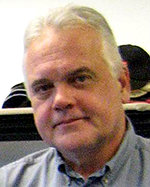
Steve Gurtin, Central Shop, died Nov. 2. Photo courtesy of Central Shop |
Steve Gurtin, transportation acquisition supervisor at the Central Shop, died Nov. 2.
Gurtin, 62, started working with MnDOT at the Central Shop in 2009. He worked at the DNR in procurement for many years previous to starting at MnDOT.
“Steve had a wealth of knowledge in state government procurement. He was sought out by others for his expertise,” said Bob Ellingsworth, fleet manager at the Central Shop.
Memorial services for Gurtin are pending. |
 |
|

|
 |
TABLE of CONTENTS
 |
Craig Gustafson takes over as MnDOTís new Chief Counsel |
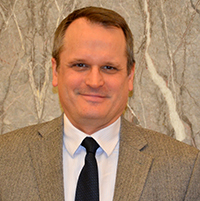
Craig Gustafson is MnDOTís new Chief Counsel. Photo by Rich Kemp |
Craig Gustafson began as the new Chief Counsel Nov. 15. Gustafson replaces Betsy Parker, who retired in October.
In this role, Gustafson will lead a team of experts who will provide advice and counsel for MnDOT’s various legal needs that can range from data practices, to contracting law, to land use and drone regulations.
“I’m honored to be joining the staff of MnDOT as the new Chief Counsel,” said Gustafson. “With all the recent developments in new technology relating to transportation, this is an exciting time to be working at the department. My predecessor, Betsy Parker, has assembled a great team in the Chief Counsel’s office. Over the next several months, I look forward to meeting staff from all the divisions and offices of MnDOT to determine if there are any areas that the Chief Counsel’s office can provide additional advice or assistance when dealing with legal issues.”
Gustafson served as the General Counsel and director of Unemployment Insurance Legal Affairs and Appeals for the state Department of Employment and Economic Development before coming to MnDOT. He also worked as the Chief Unemployment Law Judge for Minnesota and served as an attorney for the Minnesota State Legislature in the Office of the Revisor of Statutes. He is a past president of the National Association of Unemployment Insurance Appeals Professionals.
Gustafson grew up in West St. Paul, and attended Henry Sibley High School. He holds a BA degree in history from Gustavus Adolphus College in St. Peter, and earned a Juris Doctorate degree at Cornell University in Ithaca, N.Y. |
 |
|

|
 |
TABLE of CONTENTS
 |
Employees meet for Employee Resource Group Summit |
By Rich Kemp
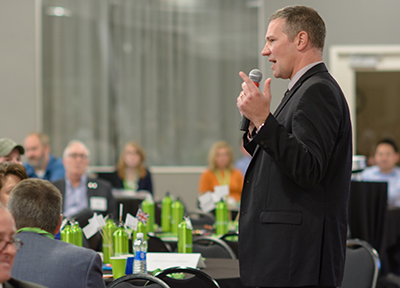
Eric Davis, chief of staff, spoke to employees during the ERG Summit Nov. 1. Photo by David Gonzalez |
More than 150 employees attended the first Employee Resource Group Summit Nov. 1 in St. Paul. The summit gathered members of MnDOT’s nine ERGs to acknowledge the work of the groups.
Commissioner Charlie Zelle and Eric Davis, chief of staff, spoke to those in attendance about the chance to reflect and celebrate past achievements of the ERG groups.
“We are fortunate at MnDOT to have nine Employee Resource Groups actively helping attract, integrate, engage, develop and retain our increasingly diverse and talented workforce,” said Davis. “Similarly, our ERGs help us more effectively engage an increasingly diverse Minnesota, gathering information and diverse perspectives to help us address transportation needs in ways that are more broadly supported and sustainable.”
Peter Frosch, Greater MSP vice-president, talked about employment in the Minneapolis – St. Paul region. GREATER MSP is a private-public non-profit partnership committed to growing the region’s economy by accelerating job growth and capital investment.

Employees from nine ERG groups attended the ERG Summit. Photo by David Gonzalez |
“We had a good turnout for our first summit,” said Mary Young, Diversity and Inclusion organizational development coordinator. “It was exciting watching all the ERG members engage with each other.”
Each ERG created a poster for the event. The leaders of each ERG spoke about meaning of their poster. They also explained the purpose of their group, what they have accomplished and what they have planned for the future.
The employees represented the nine MnDOT ERG groups:
- African American ERG
- Asian ERG
- FUEL ERG – Fully utilizing employees without labeling
- Indigenous ERG
- Q&A ERG - LGBTQ & Allies
- Latino-American ERG
- SPECTRUM ERG – Autism spectrum
- SWAT ERG – Strategic women advancing transportation
- Veterans ERG
“It is important to have the support of the senior leadership and to have the Commissioner Zelle and Eric Davis there all day demonstrated that,” said Young.

The Veterans Employee Resource Group held a Lunch and Learn event Nov. 8 at CO. (from left) Kevin Gutknecht, Office of Communications director, Eric Davis; chief of staff; Reginald Cook, Office of Civil Rights; and Teresa Chapman, Office of Transportation System Management; discussed their military service during the event. Tim Tabor, Office of Transportation System Management; moderated the event. If you missed the event, check out the video. For more information about the group, contact Tim.Tabor@state.mn.us. Photo by Rich Kemp |
|
 |
|

|
|

|
 |
TABLE of CONTENTS
 |
Employees participate in community events around the state |
By Kjensmo Walker, Public Engagement and Constituent Services

District 2 staff shared information about a pending roundabout at the Hubbard County Fair in Park Rapids. Photo by TJ Melcher |
Over the summer of 2017 MnDOT participated in more than 60 community events around the state. Some of the events included county fairs, street festivals, Fourth of July parades, local Chamber of Commerce events, National Night Out, transportation specific events, cultural and ethnic celebrations, farmer’s markets, block parties, parades and ice cream socials.
Raising awareness about roundabouts was a common theme. District 1 used a Cable Access video on the benefits of roundabouts and how to drive them while improving perception of roundabouts at the St. Louis County Fair in Chisholm. District 2’s goal was to share information about a pending roundabout at the Hubbard County Fair in Park Rapids. District 7 provided golf carts for drivers to practice driving the roundabouts while educating drivers at the same time.
Attracting interested potential employees was a goal for some events. District 6’s maintenance workers provided information about their affiliation with the local community college’s truck driving program, maintenance opportunities and how to apply for positions within MnDOT. They also featured a snowplow and sno-go machine for tours and had over 500 people stop by their booth at the Mower County Fair.
At the Rochester Transportation Fair, snowplow operators were there with a snowplow and let kids sit in the cab while talking with parents. At a “Touch a Truck” event, a snowplow was placed next to a city plow and staff were able to explain who covers what roads, while also showing kids the size of the plows.
Celebrations were not limited to community events, as Metro District was at the St. Croix Crossing ribbon cutting where 2,500 attendees were on hand to celebrate and hear elected officials speak about the new bridge.
Many events in the Twin Cities metro area were local community events and focused on engaging around the I-35W/I-94 project and the Rethinking I-94 project between Minneapolis and St. Paul.
Having good weather and good booth location are ideal, but are often not factors MnDOT could control.
“We were given a really good location and it made a difference,” said Jeremiah Moerke, District 4 public affairs coordinator. “Nearly everyone had to walk by us at some point.”
Even with the bad weather at one event, Beth Petrowske from District 1 said, “We felt we made a difference in public attitudes.”
When attendance was low, Metro District staff Kevin Walker said, “We had plenty of time to give more in-depth details about the project.”
“It takes time and resources to do the events, but we had good turnouts and positive feedback,” said Rebecca Arndt, District 7.
MnDOT’s presence at county fairs and community celebrations was a good reminder to the community that MnDOT employees live in the communities it serves.
More information about MnDOT’s public engagement efforts is on the Public Engagement iHub site. |
 |
|

|
|

|
|

|
 |
TABLE of CONTENTS
 |
Planners recognized at annual workshop |
By Judy Jacobs

2017 MnDOT Planners Award recipients project leads Chris Morgan, Bryan Anderson, Liz Walton, Cindy Bellefeuille and Ed Fairbanks received their plaques at the recent All Planners Workshop held on Oct. 12. Not pictured Peter Morey, Jeff Saholt, Lindsey Hanson, Josh Root, Bob Wolbeck, Lindsey Knutson Bruer, Nicole Bitzan and Jon Mason. Photo by Katie Caskey |
The MnDOT’s Planners Awards were presented at the All Planners Group workshop held Oct. 12. The Planners Awards are presented annually, based on innovation in advancing planning and moving the agency forward. This award also recognizes MnDOT planning work that pushes the envelope, explores new opportunities and creates new standards.
The Innovation Award winner was “Airport Influence Areas Web Map Application,” led by Chris Morgan. The award recognized MnDOT planning work that went above and beyond standard outreach practice and expectations to be more inclusive and effective. The project allows project managers access to an interactive map that displays the influence areas for airports that are part of the public system.
The Outreach/Involvement Award recipients were the “Tri-Party Tribal Boundary MOU” team, led by Peter Morey, Cindy Bellefeuille, Ed Fairbanks, Jeff Saholt, Lindsey Hanson, Josh Root and Bob Wolbeck. The MOU involves 10 of Minnesota’s 11 tribes and the U.S. Census to share data on the boundaries of tribal nations and trust lands—the only MOU of its kind in the nation. The award recognizes that quality outreach and involvement are critical to successful planning.

2017 MnDOT Planners Outreach/Involvement Award recipients for the Tri-Party Tribal Boundary MOU are (from left) Jeff Saholt, Peter Morey, Josh Root, Bob Wolbeck and Lindsey Hanson. Photo by Judy Jacobs |
The Technical Award was presented to Liz Walton for her lead in the “North Start Bicycle Route (U.S. Bicycle Route 41)” The route is 315 miles long and connects St. Paul to Canada. The route was created by using existing roads and mixed-use trails in a partnership with road and trail authorities.
Honorable Mentions were awarded to the “Highway 23 Marshall Safety Assessment” project, led by District 8 planner Lindsey Knutson Bruer, for innovative public outreach methods that included Wikimaps, pop-up meetings, Facebook live and one-on-one meetings. District 3 lead planners, Nicole Bitzan and Jon Mason, also received an Honorable Mention for their work on the “MnDOT District 3 Population Profile and Inventory of Recommended Strategies for Improved Public Outreach.” This project mapped land use population density data and layered data with the projects in the district’s 10 year Capital Highway Investment Plan and developed county assessments, augmented with maps and narrative based on social vulnerability factors. |
 |
|

|
 |
TABLE of CONTENTS
 |
District 1 receives project awards |
By Beth Petrowske, District 1 public affairs coordinator
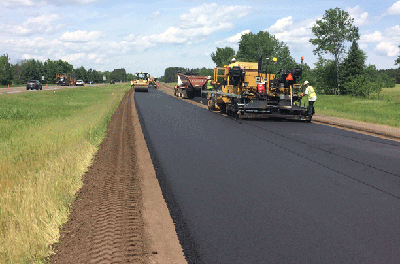
Bituminous pavement, using the "echelon paving" method on I-35 in Pine County. Photo courtesy of District 1 |
District 1 will receive a Merit Award at the 2017 Annual Asphalt Pavement Association awards banquet, for a resurfacing and rehabilitation project on Interstate 35 in Pine County. The recently completed project included the resurfacing of nine miles of northbound and southbound I-35, drainage improvements, new lighting and guardrail.
The project was judged best in the “Trunk Highway Reconstruction” category.
“This is a very special recognition,” said Aaron Gunderson, District 1 resident engineer. “The project won in a competitive category that considers value and quality, driven by innovation and sound engineering.”
The echelon paving method was used on the project. An echelon paving operation uses two pavers that operate side-by-side, paving the entire width of the road at once. This is the first echelon paving project in District 1. Echelon paving results in a higher quality pavement with a longer service life and less cracking.
A process called “full depth reclamation” was also used on the project. This process involves recycling the old pavement and using it as the base aggregate for the new pavement.
The project was completed on schedule and on budget.
To learn more visit: http://www.dot.state.mn.us/d1/projects/i35willowriver/index.html.
District 1 also will receive a merit award at the 2017 annual Grading and Base Forum, for work on Hwy 1.
The award-winning work is part of the Eagles Nest Lake Area project to reconstruct Hwy 1/Hwy 169.
Hwy 1 was nominated for the grading award due to the projects complexity, size and uniqueness. |
 |
|

|
 |
TABLE of CONTENTS
 |
Seema Desai receives Rising Star Award at WIPS conference |
By Lisa Dejoras, Resource Management
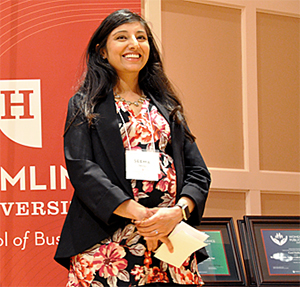
Seema Desai received the 2017 Women in Public Service Rising Star Award. The award was presented Nov. 3 during the annual Women in Public Service Conference at Hamline University. Photo courtesy of Hamline University |
Seema Desai, acting director for the Office of Equity and Diversity, was recognized Nov. 3 at the Women in Public Service Conference at Hamline University as an up-and-coming leader in advancing the critical work of equity in the State of Minnesota.
Desai’s background in public service includes work in employment law, discrimination law, civil rights, cultural competency and MnDOT’s OED.
Kris Norman-Major, of Hamline’s public administration program, presented the WIPS Rising Star Award, recognizing Desai’s contributions to “advance the imperative of parity for each of the pillars of public administration: effectiveness, efficiency, economy and equity; with equity as the lens through which the other pillars are meaningfully accomplished.”
Desai was also featured as a panelist at the WIPS conference. During her remarks, she outlined the business reasons supporting MnDOT’s OED work and discussed the reasons why employers must commit to expanding intercultural competence and diversifying the workforce. Desai also spoke to the importance of being a change agent within a state agency and highlighted some of OED’s programs, including Employee Resource Groups, diversity and inclusion training, and infusing compliance areas with best practices.
For additional information about the WIPS conferences, seminars and awards see: https://www.hamline.edu/women-in-public-service/. |
 |
|

|
 |
TABLE of CONTENTS
 |
What does customer engagement look like? |
By Tim Henkel, assistant commissioner for the Modal Planning and Program Management Division and
Mitch Rasmussen, assistant commissioner for the State Aid and Radio Communications Division,
Co-Champions of the WIG 2.0 Improve Intentional Customer Engagement Priority
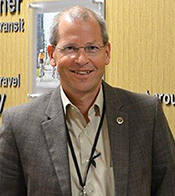
Tim Henkel, assistant commissioner, Modal Planning and Program Management Division and co-champion of WIG 2.0 Improve Intentional Customer Engagement Priority. Photo by Judy Jacobs |
Does all of the talk and action associated with WIG 2.0’s priority to improve intentional customer engagement have you wondering what customer engagement is or what it looks like?
We posed that question to WIG 2.0 improve intentional internal customer engagement focus area and goal area champions and MnDOT employees to capture their thoughts and perspectives in a video called, “What Does Customer Engagement Look like?” You’ll be able to watch the video of their comments in the next edition of Newsline as part two in a series of three Newline articles about improving intentional customer engagement.
We know this is an important issue with MnDOT employees. It’s evident in the number of WIG teams working on sub-WIGs to improve intentional customer engagement. Of the over 700 sub-WIGs either completed or under way across the state, 620 have an intentional customer engagement focus.
We see the need to focus on two areas. The first is internal customer engagement. This focus area is influenced by the goals to improve customer involvement, consider customer impact and improve customer experience. We challenge everyone to ask themselves:
- Who are my customers?
- What do my customers want?
- What is my goal for addressing my customer’s needs?
- What does it look like when an employee has a customer-centered mindset?
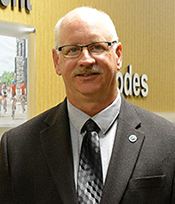
Mitch Rasmussen, assistant commissioner, State Aid and Radio Communications Division and co-champion of WIG 2.0 Improve Intentional Customer Engagement Priority. Photo by Judy Jacobs |
We all contribute to this effort in how we interact with each other every day. It’s those daily interactions with each other that determine the quality of our own experiences as customers.
The second focus area is external customer engagement. This focus area’s goals are to improve customer involvement, consider customer impact and improve customer experience.
The move toward a customer-centered mindset is a journey. The WIG 2.0 priority of improving intentional customer engagement is the starting point. We know that this mindset shift cannot--and will not--happen overnight. Research on successful customer-centered organizations such as Target and Best Buy reveal that there are very distinct stages of the journey to a customer-centered culture.
Our goal for our WIG 2.0 efforts is to change our mindset and our actions from “pushing products” to “solving customer problems.”
In the upcoming months we challenge you to think about what your customers are really asking before you jump to an answer for them. Use your exceptional technical knowledge and creativity to change the way you engage customers, and then design solutions that meet their diverse needs based on what customers have told us they want.
If you need any help along the way or have questions, feel free to reach out to either of us, a WIG Champion, your local coach(es) or the WIG Team. |
 |
|
| |
|



